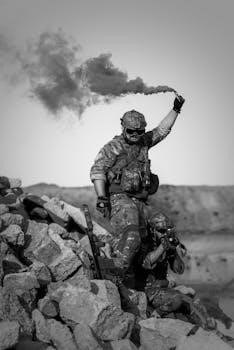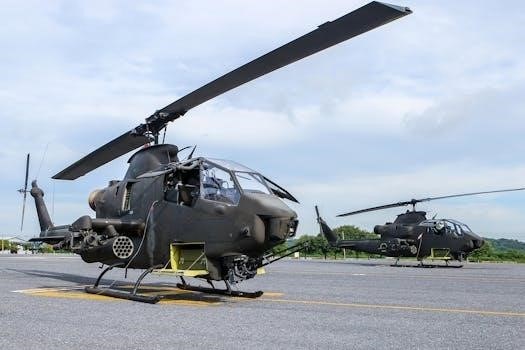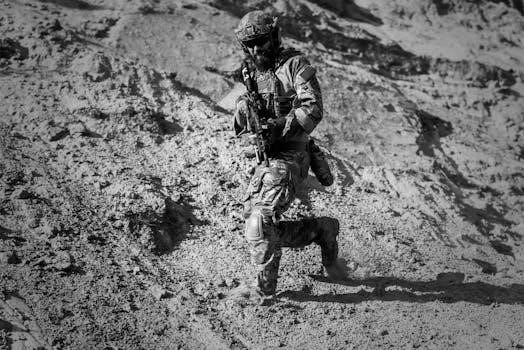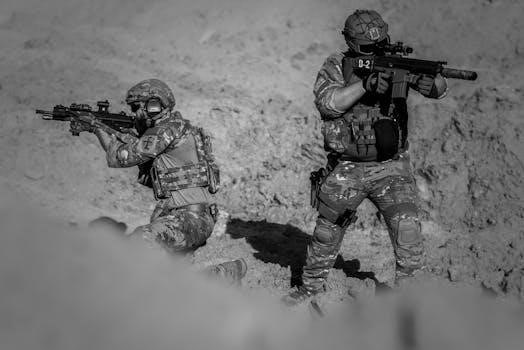
army combatives level 1 pdf
Level 1 of the Army Combatives Program introduces soldiers to basic hand-to-hand combat techniques․ This initial training focuses on foundational skills, essential for building confidence and competence in close quarters battle․
Overview of the Army Combatives Program
The Army Combatives Program (MACP) is a comprehensive system designed to equip soldiers with the necessary skills for hand-to-hand combat․ It emphasizes a progressive approach, starting with basic techniques in Level 1․ This program integrates various martial arts disciplines, creating a versatile and effective fighting system․ The program is constantly updated based on battlefield experiences and advances in fighting methodologies; It serves as a vital component of soldier training, ensuring readiness for diverse combat situations and is designed to be instinctive․
History and Development
The Army’s combatives program has evolved significantly, with early manuals dating back to 1852․ The program has been refined over time to adapt to modern combat needs․
Early Combatives Manuals
The U․S․ Army’s journey in hand-to-hand combat is marked by the publication of its first combatives manual in 1852, a translation of a foreign text․ These early manuals provided foundational techniques for soldiers, often emphasizing bayonet fighting and basic grappling․ These initial documents laid the groundwork for future combatives doctrine․ These historical resources showcase the evolution of combat training, from basic principles to the development of more sophisticated methodologies․ They demonstrate the army’s continued dedication to improving soldier’s fighting abilities, with each new manual reflecting lessons learned and advancements in combat․ These manuals serve as a critical reminder of the army’s long-standing commitment to hand-to-hand combat․
Modern Army Combatives Program (MACP) Evolution
The Modern Army Combatives Program (MACP) emerged in the 1990s, addressing the need for improved hand-to-hand combat training․ Prior to MACP, the Army had a combatives manual, FM 21-150 from 1992 but lacked a comprehensive program․ MACP was developed based on lessons learned and exposure to more effective fighting styles․ This evolution resulted in a more adaptable and effective combatives approach․ The program is continually updated based on the experiences of soldiers on the battlefield․ It emphasizes techniques that are practical and effective in real-world combat situations․ The MACP represents a significant shift towards a more modern and comprehensive combatives training system․ This ensures soldiers are prepared for the close-quarters battle․

Level 1 Training
Level 1 training in Army Combatives is a basic course structure․ It introduces core techniques․ Soldiers learn fundamental skills for close-quarters combat․ This is vital for basic training․
Basic Combatives Course Structure
The Basic Combatives Course, specifically Level 1, is structured as a four-day program․ It is designed to provide soldiers with an introduction to fundamental combatives techniques․ The course progresses logically, ensuring soldiers grasp core skills before advancing․ This training emphasizes practical application and instinctive reactions․ The curriculum includes drills that simulate real-world scenarios․ It is designed to build confidence and competence in close-quarters combat․ The aim is to develop a solid foundation for further combatives training․ It is built upon a natural progression of techniques, making it accessible to all soldiers regardless of prior experience․ This is part of the institutional training foundation․
Core Techniques Taught in Level 1
Level 1 training centers on core combative techniques that are foundational for all subsequent levels․ These techniques emphasize controlling an opponent․ Soldiers learn how to establish and maintain dominant positions․ They focus on basic takedowns and escapes from disadvantageous positions․ The training covers fundamental grappling skills․ It incorporates positional control․ It also focuses on techniques like the clinch, and basic submissions․ The curriculum includes drills designed to build muscle memory and instinctive reactions․ These basic techniques are taught in a logical progression to ensure proper understanding․ This prepares soldiers for more advanced training․
Key Elements of Combat
Controlling range is a primary element․ Soldiers also learn to manage angles and levels․ These are crucial for gaining advantages in a confrontation, maximizing effectiveness and control․
Controlling Range, Angle, and Level
In Army combatives, mastering range, angle, and level is paramount for success in close-quarters combat․ Range management dictates the distance between fighters, influencing the type of techniques that can be used․ Maintaining the proper angle allows for better leverage and control, enabling soldiers to exploit vulnerabilities․ Level changes can disrupt an opponent’s balance and create openings for takedowns or strikes․ Understanding these elements is essential for soldiers to effectively control a fight and neutralize threats while minimizing their own risk․ These concepts are integral to the combatives philosophy․

Training and Instruction
Combatives training relies on skilled instructors who guide soldiers through techniques․ They emphasize a natural progression, ensuring a solid foundation for more advanced skills, thus enhancing soldiers’ abilities․
Instructor and Trainer Guidance
Instructors and trainers play a crucial role in the Army Combatives Program, acting as mentors and guides․ Their primary responsibility is to ensure the safe and effective learning of all soldiers․ They use the official manuals to direct instruction, emphasizing a step-by-step approach to master techniques․ These leaders are often MACP Level 2 or 3 certified, demonstrating a high level of proficiency․ Their expertise helps soldiers build a solid foundation in combatives․ They must also be adept at adapting training to fit the specific needs of their students․ Ultimately, instructors are key to developing confident and competent soldiers․
Progression of Techniques
The Army Combatives Program follows a structured progression of techniques, starting with the most fundamental skills․ This method ensures that soldiers build a solid base before advancing to more complex maneuvers․ Techniques are taught in a logical order, allowing for natural skill development․ The program prioritizes safety and effectiveness, focusing on controlling range, angle, and level in a fight․ This phased approach helps soldiers master each step, building confidence gradually․ This progression ensures that soldiers are well-prepared for the demands of close-quarters combat․
Resources
The Army provides official handbooks and field manuals detailing combatives techniques․ These resources offer comprehensive guidance for soldiers, instructors, and trainers involved in the program․
Official US Army Combatives Handbook
The official US Army Combatives Handbook is a crucial resource, providing detailed information on techniques, safety protocols, and competition rules․ This comprehensive document serves as the primary guide for the Modern Army Combatives Program (MACP)․ It outlines the history and development of the program, emphasizing its evolution since the 1990s․ The handbook includes detailed instructions on how to execute various combative maneuvers and emphasizes the importance of controlling the elements of the fight, such as range, angle, and level․ It is an indispensable tool for both soldiers and instructors involved in the program․
Field Manuals and Soldier Training Publications
Field manuals and soldier training publications support individual training within the Army Combatives Program․ These documents provide guidance on rifle-bayonet fighting and hand-to-hand combat, supplementing the official handbook․ They are continually updated based on lessons learned from the field and exposure to more effective fighting techniques, ensuring soldiers receive the most current training․ These resources assist commanders, trainers, and soldiers in understanding and implementing combatives principles․ They also offer insights into the progression of techniques, helping to build a solid foundation for combat readiness․

Implementation
Combatives training is integrated into basic training, where soldiers learn foundational techniques․ Institutional training further develops these skills, establishing a solid base for advanced combatives․
Combatives Training in Basic Training
All soldiers undergo Level 1 Basic Combatives training during their initial entry into the Army․ This fundamental training is conducted by drill sergeants, who are certified at MACP Level 2 or 3, ensuring quality instruction․ The program is designed to provide a basic foundation in hand-to-hand combat, focusing on essential techniques that are easy to learn and apply under pressure․ This initial exposure to combatives is crucial for developing the confidence and physical skills needed for close-quarters engagements․ The training emphasizes instinctive movements and controlling an opponent using techniques that are progressive in nature, building upon a fundamental base․ It is a critical component of basic training․
Institutional Training Foundation
Army institutional training plays a pivotal role in establishing a robust foundation for combatives proficiency․ This training is designed to build upon the basic skills learned in Level 1, providing soldiers with a progressive understanding of combatives techniques․ The focus here is on developing a deeper understanding of the techniques and preparing soldiers for higher levels of training․ This institutional approach ensures a standardized and continuous development of combatives skills across the Army․ The training is structured to support the planning of battalion-level or higher programs and to build a strong skill set in soldiers․ It is a key part of a soldier’s comprehensive military education․

Competition
Basic competition rules are designed for entry-level soldiers, emphasizing safety and practical application of learned techniques․ The competitions are a controlled environment to test skills․
Basic Competition Rules
The basic competition rules within the Army Combatives Program are structured to ensure a safe and controlled environment for participants, especially those at the entry level․ These rules are designed to test the practical application of the techniques taught in Level 1 training, focusing on fundamental skills․ Competitions typically involve grappling-based scenarios, where soldiers apply learned maneuvers to control and subdue opponents․ The emphasis is on technique and control, rather than brute force․ Safety measures are strictly enforced, with clear guidelines to prevent injuries during the matches․ These rules help soldiers build confidence, demonstrate their skills, and further their understanding of combatives principles․